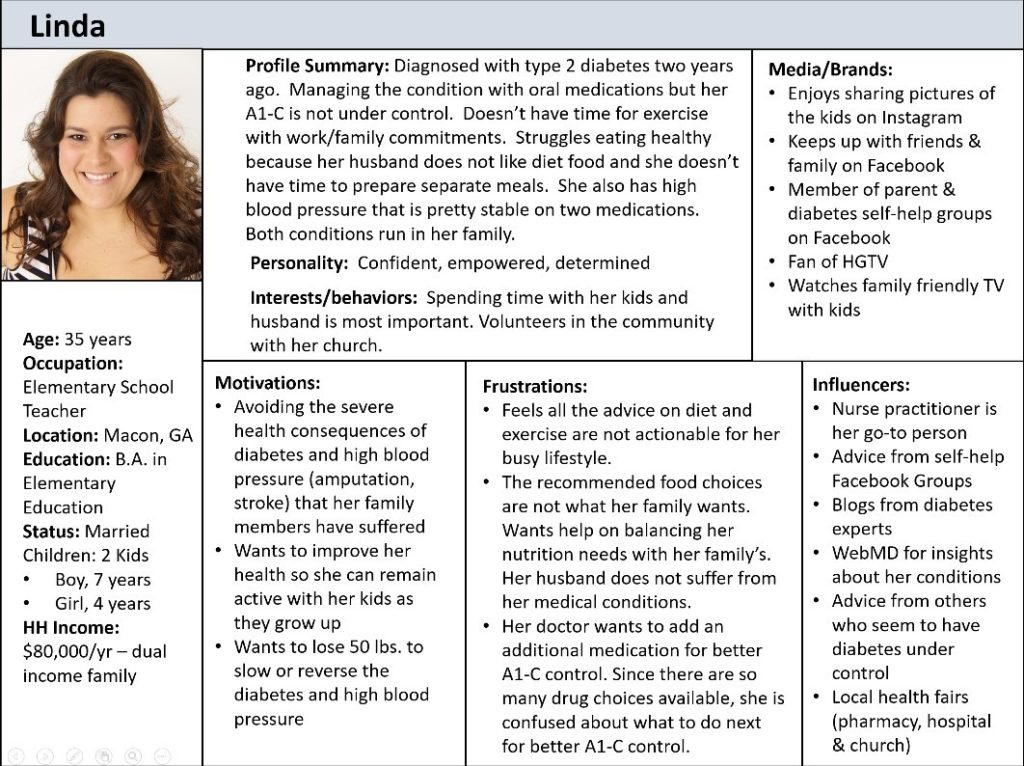The Ultimate Guide to Creating Customer Personas in Health and Life Sciences

Today’s customers expect the products, services, and messages they receive—from a pair of socks to a new prescription—to be customized to their individual needs. As marketers, that means we need to create materials that speak “one-to-one” with them.
One of the best ways to accomplish this is to employ customer personas (a.k.a. buyer personas). Customer personas take the customer from a generalized customer profile based on a segmentation study to the living, breathing beings that they are. Understanding exactly who the customers are is imperative to developing a marketing plan that will reach, connect, and motivate them.
Customer personas have been used in the retail and consumer packaged goods (CPG) industries for some time, but their use is relatively new in the health and life science space. This article will apply those best practices to the healthcare industry and outline four key steps for developing actionable customer personas for life science, with the focus on the word “actionable.” Personas are not just an exercise in your marketing plan that never gets pulled through—instead, they should be something that drives the key deliverables of that plan.
What is a Customer Persona?
A customer persona is a description of your ideal customer that’s based on market research and real data that you’ve gathered about your current customers. It is a fictionalized, composite sketch of a specific target segment. It identifies the segment’s key characteristics and concerns, and it’s based on both qualitative and quantitative data from sources like:
- Qualitative Research: customer interviews (phone or in-person), focus groups, and ethnographic research
- Quantitative Research: web and CRM program analytics, market segmentation tools, customer surveys, and other internal data
A customer persona also provides insight into what your customers are thinking as they weigh their options for addressing a problem that your product could help them solve. An actionable persona should reveal insights about what drives the customer’s purchase decision, such as their assumptions, anxieties, and questions. It will help you uncover unmet or under-met needs and understand how to speak more effectively to their concerns.
Why Are Customer Personas Important?
Customer personas provide value by:
- Giving you a better understanding of customer needs and how best to meet those needs
- Guiding product development for synergistic products or services
- Helping you prioritize the projects and initiatives that will be most valuable to the business
- Creating alignment across the organization on a customer-centric vision
Constructing actionable customer personas also has the potential to save your organization money and drive increased sales by shifting the focus onto what’s most important to your buyers.
Step One: Select your target customers
Customer personas can be done for any relevant target customer type, such as:
- Patients
- Physicians or Healthcare Providers
- Key decisions makers in Payer or Managed Care organizations
Remember, you are targeting a person, not an organization or company. Decision makers are human beings, not corporate entities. To accomplish this step, you’ll need to utilize hard data.
For each customer type, identify the top segments that are most desirable for your business. Segment your customers by demographic data, including age, gender, income, profession, interests, attitudes, and more. The best place to find this data is in a recent segmentation study, where you should concentrate on the top two segments by customer type. If you don’t have a recent segmentation study at your disposal, you can also glean a lot of data from web analytics about who is visiting your brand’s product or service website. If the brand is engaged in social media, get data from social platforms about who is interacting with it there. Social media listening research is another a great way to gather information about a key target, or you can look for data from your call center and CRM (Customer Relationship Marketing) programs. The point is to use the best available data to define the most valuable customers for persona development. There is no need to develop personas for every customer segment, just the top segments that drive business.
A key way to go wrong with persona development is to base it on irrelevant data, poorly sourced data, or no data at all (your gut). Do not include things that could never be known about a customer, just because it feels like it fits. Successful personas should help you develop a clear picture of what drives different kinds of customers to purchase your products or services. This is best accomplished with a combination of qualitative and quantitative data. Qualitative research will help you identify the knowledge gaps you’ll need to address through quantitative research.
Most personas are done on customers that are desirable targets for your company’s products or services; these are known as positive personas. There is also value in creating negative personas to target audiences that are unlikely to purchase your products or services. Negative personas are a great way to identify undesirable targets and help your salesforce easily recognize them, thereby avoiding wasted time and money.
Step Two: Pull your data together
Now that you’ve identified the top customer segments you’d like to target, the next step is to form a cross-functional team to develop the corresponding personas. Keep this team limited to a core group of people that have significant knowledge about the customer, and take care not to allow it to become too large. You’ll need to involve key stakeholders to ensure buy-in, but you can gather and add input from others added as needed. This will help ensure the development process moves smoothly and efficiently.
People to consider for the core team could be representatives from the following areas:
- Marketing (team leader)
- Market Research
- Sales
- Key Agency Partners
- Marketing Operations (web & CRM analytics)
- Call Center (Voice of the Customer)
In order to bring the customer persona to life, focus on using the data you have to answer questions in five key areas:
- Demographics: Age, location, education, income, household size
- Activities and Behaviors: Important habits and activities in daily life
- Personal Histories: Goals, needs, and interests when interacting with the product or service
- Expectations: Different needs at various touch points and how those needs are or aren’t being met
- Decision Criteria: Strongest reasons for buying and the key influencing factors
In addition to data that is already available, you may need to do additional research to address your knowledge gaps and make sure that these questions can be answered in a meaningful way.
Finally, as you develop your personas, make sure to avoid these missteps:
- Don’t use information that’s based on a very small sample size
- Don’t use data that’s not a key driver of purchasing behavior
- Avoid developing too many personas
- Avoid conducting customer interviews in a leading way and thus not getting a natural response from your customers
Step Three: Create your provider, payer, and/or patient personas
Once your core team has reviewed the available data and conducted the research it needs to fill any knowledge gaps, they’ll need to distill what they’ve learned and zero in on the things that are most important in driving purchase intent. A persona is not a data dump that includes everything you know about a target, but rather a clear picture of a customer who’s likely to purchase your products or services. Focus on gleaning insights that speak to their needs and barriers to purchase, along with what drives them to want to buy.
There is no correct template for a customer persona. However, they all contain the same basic information:
- Demographic data
- Personality
- Interests and behaviors
- Role in the purchase decision
- Motivations and frustrations
- Goals and challenges
- Influences
Depending on the data that’s available and the insights that you’ve gleaned, you can adjust what you include in the persona to construct a living breathing being (or as close to one as possible).
Here’s a hypothetical diabetes patient persona as an example:

Keep in mind that customer personas are living documents and should be revisited as new information is collected so they will always be up-to-date.
Step Four: Make it useful
Once you’ve finished developing your customer personas, you can use them to inform your marketing plan and determine which communications strategies will be most effective. You can also use them to develop more motivating and targeted messaging.
When you think about the communications channels through which you’ll reach your customers, use your personas to understand:
- The format through which your customers prefer to get information
- Which types of media they consume
- Their social media habits and preferences
- Key influencers
Then, align your communications strategy with your target customer segments to create messaging, content, and campaigns that resonate. The persona should reveal what customers want to hear and help you persuasively address issues like:
- Budget constraints
- Pain points
- Key interests and motivating factors
- Barriers to purchase
- Core values
- Dreams and expectations
- Fears
In summary, customer personas go beyond the generalized profiles that are developed in segmentation studies to help you forge stronger connections between your products and your customers. Today’s healthcare payers, providers, and patients are more engaged than ever with the choices that matter to their constituents, budgets, and health outcomes. Take the time to understand their specific needs and concerns will dramatically increase the effectiveness of your interactions with them.
This article first appeared on Regina’s blog.
Get the Skills You Need
Thousands of independent consultants, subject matter experts, project managers, and interim executives are ready to help address your biggest business opportunities.